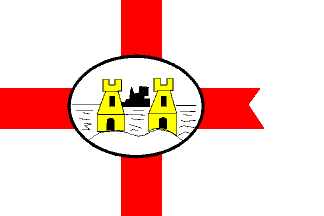 Ebenezer Pike
(1806 - 1883)
Ebenezer Pike
(1806 - 1883)
Joseph Pike
(1851 - 1934)
Ebenezer Pike
(1853 - 1931)
Cork Steamship Company
1843 to 1918
by Shaun Boylan
Ebenezer Pike Chairman of the Cork Steamship Company 1843 - 1883
Joseph Pike Chairman of the Cork Steamship Company 1883 - 1918
Buy out of the Cork Steamship Company 1918
Saint George's Flag
Ebenezer Pike
Chairman
of the Cork Steamship Company
1843 - 1883
-1860s.jpg)
When steamships started being built, the Pike family became involved in the steamship industry, the main member being Ebenezer Pike (1806-1883), a descendant of Richard Pike (1627-1668) of Sarsfields Court.
Ebenezer Pike was married to Lydia Clibborn Pike (1823-1900) (also a descendant of Richard Pike) and they had three sons and seven daughters.
In 1843, the St George Steamship Co. had begun to encounter difficulties and by October 1843, the venture had been organised into the City of Cork Steamship Co. (shortly after, the Cork Steamship Co.) with Pike as both chairman and managing director, and a capitalisation of £170,000, of which he was the largest shareholder.
Mr. Ebenezer Pike was the 'guiding star' of the company as well as many directors namely, Messrs John Could, James Connell, Joseph Hayes, William Lane, and Joseph Leycester, who were a respected group of Cork's citizens.
The new Cork Steamship Co. inherited seven ships from its St George Steamship Co. predecessor and expanded by purchasing its first steamer.
The following steamers were built by Mr. Pike at Pike's yard, located in Water Street, Cork: SS Gannet, SS Pelican, SS Cormorant, SS Falcon, SS Dodo, SS Osprey, SS Bittern and the SS Ibis. [The SS Ibis was lost at sea Saturday 23rd December 1865 at Ballycroneen Bay, County Cork.]
In 1846, the first screw steamer in Cork, built by Robert J. Lecky, was launched on the company's Liverpool - Le Havre route, and the SS Ajax was also purchased. [Robert J. Lecky is possibly connected to Ebenezer Pike by Ebenezer's aunt Mary Pike (1769-1852), who married James Lecky (1748-1795).]
The following year (1847), Ebenezer purchased the SS Minerva and in 1848 he launched the SS Gannet from his own newly acquired shipyards at Water Street, Hargreaves Quay, Cork. At its height, the yard employed nearly 370 men.
More vessels followed with the purchase (1850) of the SS Pelican and the SS Albatross and the construction of the SS Osprey (1855) and SS Britain (1856) at Pike's yards. In 1856 he also purchased the Prussian SS Eagle, which was originally constructed as an armed yacht for the king of Prussia. The SS Halcyon and the SS Abyss were acquired for the firm in 1860.
By the 1870's, the Cork Steamship Co. had expanded to the extent that Ebenezer Pike split operations into two distinct limited liability companies. Incorporated on 12th September 1872, the Cork Steam Packet Co. Ltd, which was based at Penrose Quay, inherited nine ships from the original company and ran the coastal routes. The Cork Steamship Co. Ltd was incorporated on the same day and was responsible for the foreign and continental routes operating from Liverpool with eight of the original fleet.
Ebenezer Pike retained control over both operations, and during the next ten years (1873 - 1883), acquired six new steamers for the Cork Steam Packet Co. Ltd. Ebenezer was also a partner in a shipyard at Jarrow on the Tyne in England, with Sir Joseph Pease. Ebenezer was also a shareholder in mines in Prussia. [Sir Joseph Pease is possibly related to Hon. Arthur Pease (1837 - 1898); Hon. Arthur Pease was married to Ebenezer's daughter Mary Lecky Pike (1843 - 1915).]
In the middle of the nineteenth century, the Cork Steam Packet Co's steamers carried passengers between Cork, Cardiff and Newport. The service between these ports varied from between one and three sailings weekly, and these sailings were usually done by the SS Bittern and the SS Pelican.
In February 1851, the SS Pelican carried 609 deck passengers from Cork to London. On this journey, a child passenger died from exposure. However, the SS Pelican was said to have accommodation for 612 deck passengers, who were each provided with 434 square yards of covered accommodation.
Pike's Company was known as the Cork Steam Packet Company. There were no changes made in Pike's Company until 1871, when he separated the Continental and Home liners into two separate Companies.
The Home line was now known as the Cork Steam Packet Company Limited and the Continental line remained as the Cork Steamship Company. Pike took over nine steamers: the SS Flamingo, SS Rallus, SS Buzzard, SS Grebe, SS Quail, SS Tern, SS Kestrel, SS Ousel and SS Egret. [The SS Quail was lost at sea Monday 3rd March 1873 at Atherfield Point, Isle of Wight.]
The two separated companies continued to be successful. All the steamships were up-to-date, and in 1894, the SS Ibis, which was one of Pike's steamers, was the first steamer to enter the Manchester Ship Canal, an indication of how modern Pike's steamships were. [This SS Ibis is perhaps the second SS Ibis owned by the Cork Steamship Company, as the first SS Ibis was lost at sea Saturday 23rd December 1865.]
In the nineteenth century, the Cork Steamship Company experienced competition from the City of Dublin Steam Packet Company, and for a while, both companies promoted their services by taking passengers for nothing.
Mr. Ebenezer Pike was said to have been a generous man and was interested in providing jobs for the people of Ireland.
Return to top
Joseph Pike
Chairman
of the Cork Steamship Company
1883 - 1918
-1890s.jpg)
Mr. Ebenezer Pike died in 1883 and the Company was continued on by his son Joseph Pike (1851-1934) J.P.D.L. of Dunsland, Glanmire, Co. Cork, as chairman of the Cork Steamship Company.
Return to top
Buy out
of the Cork Steamship Company 1918
Further information provided by
councillor Kieran McCarthy
Cork City Council
Cork Independent
Newspaper Article 19th July 2018
Stories from 1918:
buying out the Cork Steamship Company
One hundred years ago this week, public concern grew to the future of one of Cork’s oldest businesses – that of the Cork Steamship Company.
A process had begun by Coast Lines Limited for the large-scale purchase of shares from the Cork company’s shareholders, through the company chairmen Ebenezer Pike and Joseph Pike. Public meetings were held in Cork City to address the consequences in terms of jobs and business to the city and region.
The Cork Steamship Company was established in 1843 under the direction of Ebenezer Pike (senior) and was built on the former structure of St George Steampacket Company in England.
The principal building still survives today on Penrose Quay and the statue of St George slaying a dragon still adorns the top of the building.
In the beginning, the Cork company bought older steamships and as well purchased new ones. In 1903, it is recorded that there were 16 vessels, varying from 1,000 to 2,400 tons.
At the request of several prominent citizens, on Monday 22nd July 1918, a public meeting convened by the Lord Mayor Thomas Butterfield, was held in the Council Chamber, in Cork City Hall (covered by the Cork Examiner). The Lord Mayor noted of the purchase, that the shareholders were concerned as to what future facilities would be accorded to the trading community of the City and County of Cork by the new deal.
He did not have knowledge of who the new owners were to be, but requested the same high business calibre as the company in place. He protested in every way that there could be a diversion of the trade of the Port of Cork, especially outside companies that have interests in other ports.
A letter was read out at the meeting, which was signed by the steamship company Chairman Ebenezer Pike. He highlighted that the transfer of shares from one set of shareholders to another in the company, was a continual process and that the number of shares to be bought were higher than ever before.
He noted that the majority of the principal shareholders were not in business anymore and their knowledge was poor of contemporary trade and shipping knowledge. The company, he claimed, could not stand alone as a single unit and it would not be able to redeem the company’s position because of the destruction of the company’s fleet during the war.
Further losses he claimed, would make it almost impossible to continue operations. He was satisfied that the proposal put forward was the best prospect of rebuilding the company in due time, from what he deemed a very difficult position.
The City Hall meeting was made open to the public for discussion.
Many present agreed with the sentiments of Mr Pike’s letter, and the need for the company to adapt to changing times, but for the trade of Cork to be safeguarded.
Major G B O’Connor proposed the motion:
“That this meeting representing the commercial community of the City of Cork and surrounding district, respectfully request the Directors and shareholders, that in any agreement come to for the sale of the Cork Steam Packet Company Ltd, the interests of the Port of Cork shall be safeguarded.
That it being vital to the prosperity of the City of Cork and the South of Ireland, that the pre-war Cross-Channel service, at least be maintained to take such steps as will render a monopoly of the Cross-Channel carrying trade of the Port of Cork, and that this condition be part of the agreement announced”.
The Register of Members of the Cork Steam Packet Company, reveals that from 14th September 1918, the British and Irish Steam Packet Company Ltd is recorded as owning Cork aggregate shares totalling 125,474, out of a total of 140,000. Further purchases brought that company’s holding to 136,417.
This information lays within the main archival body of the Cork Steam Packet Company Ltd, which was transferred from B&I Offices, Penrose Quay, Cork, in February 1984, by Mr Foley, Manager to Cork City and County Archives.
Additional material was acquired on 22nd January 2007, and form the basis of an enormous and valuable source of information on shipping and trade in Cork and beyond.
Return to top
St George's Flag
Extract From The Publiction
Irish Passenger Steamship Services Volume 2
as flown by an Admiral of the Royal Navy

In the early days, the vessels of the St. George Steam Packet Company flew the St. George Cross as a house flag.
This custom was continued by the Cork Steamship Company, a practice which caused much consternation among ships of the Royal Navy, where the un-defaced St. George Cross is flown only by Admirals.
On several occasions, masters of Cork vessels were directed to haul down their house flag by senior naval officers, an order which they refused to obey.
After one particular encounter in the Persian Gulf, the Cork Steamship Company decided to placate 'Their Lordships' of the Board of Admiralty by altering its house flag to a St. George's Cross defaced by a blue star at its center.
with the City of Cork Arms

The Cork Steam Packet Company was not affected by this decision, for its vessels have always flown the St. George's Cross with the arms of the City of Cork at its center.
Return to top